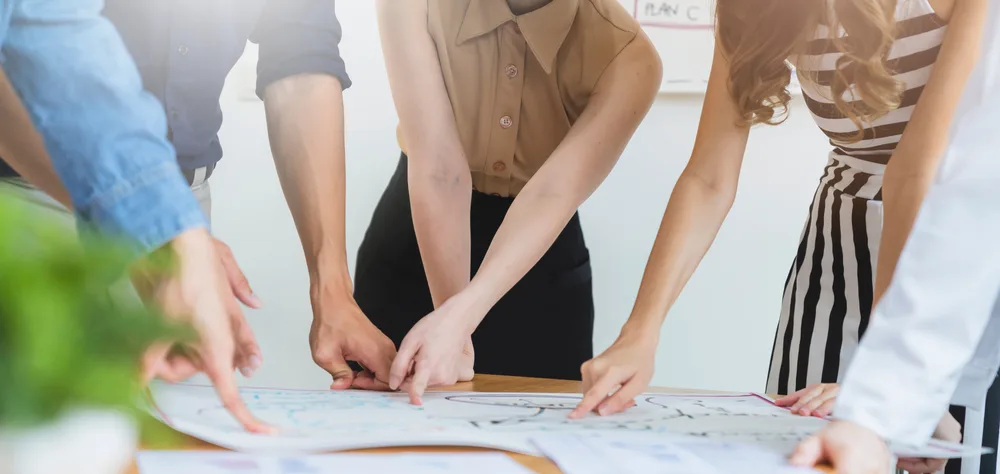Nature and business have become more intertwined than ever. Not only does it provide a source of inspiration, but it is also a resource that is in need of protection as population size and consumption grows.
In this episode of Venture unscripted., Josh Barker, CEO of City Innovations, sat down with Nicole Miller, Managing Director at Biomimicry 3.8 to talk about the role of corporate social responsibility, how to pull creative ideas from the natural world and how we can use the environment to impact innovation.
Click here to listen to the podcast or keep scrolling to read the podcast recap blog.
How it All Started: A Passion for Corporate Social Responsibility
Before working at Biomimicry, Nicole first got into sustainability as the Managing Director of Sourcing at Overstock.com.
In a matter of six years, Overstock grew from a $10 million to an $800 million company. In 2002, demand for Corporate Social Responsibility (CSR) started surfacing. As the company grew, social compliance was very much part of the manufacturers that they were working with. So what did social and environmental responsibility look like within a company?
“It fell on my lap to be responsible for that. I got into what it looks like to be socially and environmentally compliant. The thing that I think really opened my eyes is that I became privy to the manufacturing process, like what does it actually take to make a chair, to make a flat-screen TV, to make a down comforter?” explained Nicole.
“Actually seeing the environmental impacts of that was a pretty hard ground truth for me. So I got really interested in solving for that. How do we make it less bad? That’s really how I started to intersect with the sustainability world… and really started to understand what CSR looks like.”
During that time, Nicole noticed that many of the conversations around sustainability focused on developing short-term solutions.
“No one was saying ‘Hey, let’s not have plastic to begin with.’ That wasn’t even at the table at that time and barely is now,” said Nicole.
That’s when she started ideating how businesses could innovate differently and what innovation looks like when taking a holistic approach — something which Biomimicry 3.8 had at the focus of their organization.
“I think so much of innovation has been historically centered around what are the human needs that we’re solving for. There’s a bigger picture here than just making a better product faster and cheaper… I think that’s what really inspired me to start looking into what innovation strategies are more holistic in their approach and are looking at life-centered design,” stated Nicole.
Finding Holistic Solutions within Nature
Biomimicry 3.8 uses the practice of biomimicry to help innovators find inspired design solutions. Overall, they help businesses look to nature for solutions as a way to de-risk their innovation process.
“Our name is [Biomimicry] 3.8 because there are 3.8 billion years of R&D in nature that we can lean into. Nature has been solving for these challenges — thermal regulation, water filtration, all these things that we talk about as issues today. Nature has some pretty cool design strategies to solve for that… Because these strategies are already there, they give us essentially this incredible leg up to start solving for that problem in a holistic and life-friendly way,” Nicole explained.
“You can use biomimicry, whether for product design, facility design, or systems design. You can use these innovations, these strategies, and natural patterns from biology to really inform a conversation around innovation and sustainability. A lot of my role is finding the intersection with companies and helping them find the business value based on the goals and objectives that they’re trying to achieve,” she continued.
An Example of Creating Innovation in Sustainability
One example Nicole provides of creating innovation in sustainability is through packaging. When looking at a company’s challenge, the first thing Biomimicry 3.8 does is break down the challenge’s function.
“When a company comes to us and says, ‘We have too much plastic in our product, we need to design it better…,’ the first question we’d ask is, ‘What function is that plastic providing? Is it structural integrity? Or maintaining liquids? Is it serving some sort of barrier? Is it for advertising?’ Because function is really our bridge to the biology,” said Nicole.
Once they understand the function of the challenge, that provides them a space to brainstorm a solution.
This was the situation they found themselves in when working with Natura, a cosmetics company out of Brazil.
The company wanted to look at the carbon impact of their packaging for their shampoo container and what would it look like to reinvent their packaging. They had two primary goals: reducing carbon and reducing materials.
The function Biomimicry 3.8 was solving for was maintaining liquids. So they began looking at how that was done throughout nature.
“We looked at all sorts of different organisms and for example, one of the ideation sessions really latched on to this concept of citrus fruit. When you look at a citrus fruit, you have packaging within packaging within the packaging. You’ve got the pulp, which holds the liquids, the pulp is inside a section, the section is inside the fruit, which is inside the rind. And so you’ve got this beautiful packaging example that we can start to emulate,” said Nicole.
In terms of maintaining liquid, the company landed on using the shape of pulp which enabled a large amount of liquid to be captured. Instead of a round tubular shampoo bottle that you would expect, their packaging became a very short, teardrop shape.
“By doing that, [Natura] could lay a lot of the packages within a box that would then be shipped within a carton within a crate, and so forth. By just changing the shape of that bottle, they were able to reduce the carbon of their distribution of that product by 50%.”
A Call to Action for Innovators and Entrepreneurs
During the podcast, Nicole provides this advice to listeners: Pause and recognize what’s happening around you. Try to understand how everything in this world is connected.
She went on to say, “If you pick up a handful of dirt, you have 10,000 organisms in your hand. When you think about that and what they’re all doing and working towards, these incredible symbioses are happening to make our world function.”
Next time you go on a hike in the mountains or a walk in the woods, try to acknowledge everything happening around you in nature. It’s important to understand the holistic phenomenons that are taking place.
“The decisions that we make today, the products that you buy for dinner tonight, as you’re on your way home from work, actually have some sort of implication to the ecosystems in which they were harvested… As a human walking through this world, we hold so much power in the small decisions that we make in what we purchase. That’s what I think really becomes illuminated to me is one — the value of the ecosystems and these organisms that surround us, and two — how can I make a difference in my everyday practices and purchases to protect them?”
Continue Listening
Want to learn more about practicing innovation in sustainability? Click here to listen to the full podcast.
For more great venture stories, advice, and news, click here to subscribe to our email communications!
Originally recorded in April 2020.




